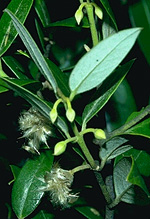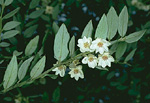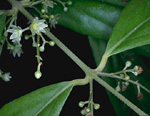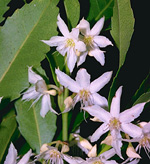 |
This small family is primarily pantropical, although some species extend into temperate parts of the Southern Hemisphere. In Australia it is restricted to tropical and temperate rainforests and wet sclerophyll forests from Cape York Peninsula south down the eastern seaboard to Tasmania, usually at high altitudes.
Characteristic features of the family Monimiaceae in Australia include: - trees, sometimes shrubby, rarely climbers
- leaves opposite, simple, leathery, shining, often toothed, sometimes minutely gland-dotted and scented when crushed
- flowers unisexual, small, greenish, with few to many free perianth parts sometimes fused into a cap which falls as the flower expands
- male flower with many stamens, female flower with few to many free carpels
- fruits small and dry or fleshy drupes, sometimes aggregated into mulberry-like compound fruits
Description
Evergreen trees, or shrubs or or woody or herbaceous scrambling vines. Extra-floral nectaries absent or on the stems. Stem nodes conspicuously swollen or not; internodes ± terete. Internal secretions not obvious, or of essential oils or resin. Plants glabrous, or with simple or stellate, non-glandular, unicellular hairs. Leaves rarely alternate and distichous, or opposite, petiolate or subsessile. Stipules absent. Lamina simple, symmetric, ovate, lanceolate, elliptic or oblong; base cuneate, cordate, attenuate or rounded; margin entire, dentate, serrate, revolute or recurved; venation pinnate, with the midrib conspicuous, and the tertiary venation reticulate or not; surfaces not punctate or punctate with dark or translucent gland-dots; herbaceous or leathery; distinctive odour absent or aromatic. Domatia absent or rarely consisting of pits or pockets in the vein angles. Male and female flowers occurring on the same plant or on separate plants, or with all the flowers bisexual. Inflorescences terminal or axillary, consisting of racemes, panicles, dichasial cymes, small clusters or solitary flowers. Bracts and bracteoles absent or present. Pollination by insects or wind. Flowers odourless or fragrant, stalked. Free hypanthium absent or present. Floral nectaries absent or present on the hypanthium. Calyptra absent or rarely present. Perianth regular, of one or more whorls, with 4-20, free, ± petaloid segments, or the outer whorl of "sepals" rarely fused, or vestigial or absent, imbricate in bud, white or cream or yellow or red, without contrasting markings, or streaked, spotted, etc, herbaceous, membranous or succulent.
Fertile stamens 4–10 or more, with no clear relationship to perianth, free from each other and from all other flower parts, ± equal. Staminodes absent or present. Staminal filaments present or absent. Anthers basifixed, not versatile, opening outwards or inwards by longitudinal slits or valves, 2-celled; appendages absent or apical.
Ovary superior, half inferior or inferior. Carpels (1–)4–30(–50), free from each other. Style terminal, single, unbranched, or absent and the stigma ± sessile on the ovary. Ovules 1 per locule; placentation basal or apical.
Fruit fleshy or dry, indehiscent; a cluster of drupes or achenes borne on or within the enlarged hypanthium; perianth on maturing fruit deciduous, or growing larger. Disseminule micro-surface ± smooth or with fine, plumose hairs, yellow, red, green, grey or black, dull. Seeds 1 per fruit. Aril absent. Cotyledons 2. Embryo straight.
(Note: this description has been generated from the coded data compiled for the key. Any errors in the key data will be reflected in the descriptions.)
A treatment of the family Monimiaceae has not yet been published in the Flora of Australia. It will appear in Volume 2.
Australian genera of Monimiaceae (as recognised for the Flora of Australia)
Atherosperma
Austromatthaea
Daphnandra
Doryphora
Dryadodaphne
Hedycarya
Kibara
Levieria
Palmeria
Steganthera
Tetrasynandra
Wilkiea

|
  |

Atherosperma moschatum (buds and fruit)
Photo: H.Nicholson © H. & N. Nicholson

Atherosperma moschatum (flowers)
Photo: M.Fagg © M.Fagg

Daphnandra repandula (flowers)
Photo: M.Fagg © ANBG

Doryphora sassafras (flowers)
Photo: D.Jones © D.Jones

|
 |
|